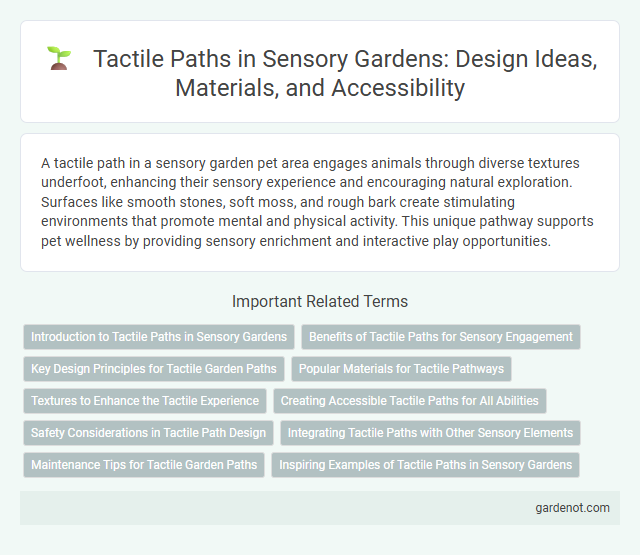A tactile path in a sensory garden pet area engages animals through diverse textures underfoot, enhancing their sensory experience and encouraging natural exploration. Surfaces like smooth stones, soft moss, and rough bark create stimulating environments that promote mental and physical activity. This unique pathway supports pet wellness by providing sensory enrichment and interactive play opportunities.
Introduction to Tactile Paths in Sensory Gardens
Tactile paths in sensory gardens are designed to engage the sense of touch through varied textures and materials, providing an immersive sensory experience. These paths often feature surfaces like smooth stones, rough bark, soft moss, and sand to stimulate tactile exploration and encourage movement. Integrating tactile paths enhances accessibility and sensory development for individuals with visual impairments or sensory processing needs.
Benefits of Tactile Paths for Sensory Engagement
Tactile paths in sensory gardens provide diverse textures that stimulate the sense of touch, enhancing sensory engagement for visitors of all ages. These paths promote cognitive development and sensory integration by encouraging exploration and interaction with varied materials like sand, pebbles, and wood. Incorporating tactile paths improves spatial awareness, motor skills, and emotional well-being, making them essential components in therapeutic and educational outdoor environments.
Key Design Principles for Tactile Garden Paths
Key design principles for tactile garden paths emphasize the use of varied textures and materials to stimulate sensory perception while ensuring accessibility for all users. Paths should have clear, contrasting tactile surfaces to guide visually impaired visitors safely through the garden, incorporating durable, non-slip materials to prevent accidents. Proper width, gentle gradients, and seamless transitions between textures enhance navigation comfort and encourage exploration within the sensory garden.
Popular Materials for Tactile Pathways
Popular materials for tactile pathways in sensory gardens include rubber, wood, and textured concrete, chosen for their durability and varied sensory feedback. Rubber offers a soft, cushioned surface ideal for barefoot exploration, while wood provides a natural, warm texture that enhances tactile stimulation. Textured concrete allows for intricate patterns and increased grip, contributing to an engaging and accessible sensory experience.
Textures to Enhance the Tactile Experience
The tactile path in a sensory garden incorporates diverse textures such as smooth pebbles, rough bark, and soft moss to stimulate touch receptors and heighten sensory engagement. These varied surfaces encourage exploration and improve fine motor skills by providing distinct tactile feedback. Integrating natural and synthetic materials enhances accessibility while promoting sensory integration for all visitors.
Creating Accessible Tactile Paths for All Abilities
Creating accessible tactile paths in sensory gardens involves designing varied textured surfaces such as gravel, sand, and smooth stones to stimulate different tactile responses, enhancing sensory experiences for individuals of all abilities. Incorporating clear, low-level guidance rails and wide, level walkways ensures navigation is safe and comfortable for wheelchair users and those with mobility challenges. Strategically placed resting spots and contrasting edge markers further aid orientation and encourage independent exploration.
Safety Considerations in Tactile Path Design
Tactile path design in sensory gardens prioritizes safety through non-slip, durable materials that accommodate diverse mobility needs and reduce trip hazards. Clear textural contrasts and consistent surface patterns enhance navigation for visually impaired users, ensuring predictable foot placement and preventing disorientation. Incorporating gentle slopes and rounded edges minimizes falls, while strategic lighting improves visibility during low-light conditions.
Integrating Tactile Paths with Other Sensory Elements
Tactile paths enhance sensory gardens by incorporating diverse textures that stimulate touch alongside other sensory elements such as aromatic plants, visual contrasts, and ambient sounds. Integrating tactile paths with fragrant herbs and visually vibrant flora creates a multi-sensory experience that engages visitors more deeply. Combining these elements promotes accessibility and encourages exploration for individuals with varying sensory preferences and abilities.
Maintenance Tips for Tactile Garden Paths
Regularly inspect tactile garden paths for wear and tear, ensuring surfaces remain even and safe for users. Clear debris and overgrown vegetation to maintain texture integrity and prevent slipping hazards. Use non-toxic sealants or treatments to protect materials from weather damage while preserving tactile elements crucial for sensory engagement.
Inspiring Examples of Tactile Paths in Sensory Gardens
Tactile paths in sensory gardens engage visitors through varied textures such as smooth pebbles, rough bark, and soft moss, enhancing sensory stimulation and spatial awareness. Notable examples include the Eden Project in Cornwall, where tactile walkways guide visitors through diverse plant collections, and the Chicago Botanic Garden's sensory trail, designed specifically for visually impaired guests. These tactile pathways encourage exploration and mindfulness by fostering direct touch experiences with natural materials, promoting inclusivity and sensory integration.
Tactile path Infographic

 gardenot.com
gardenot.com